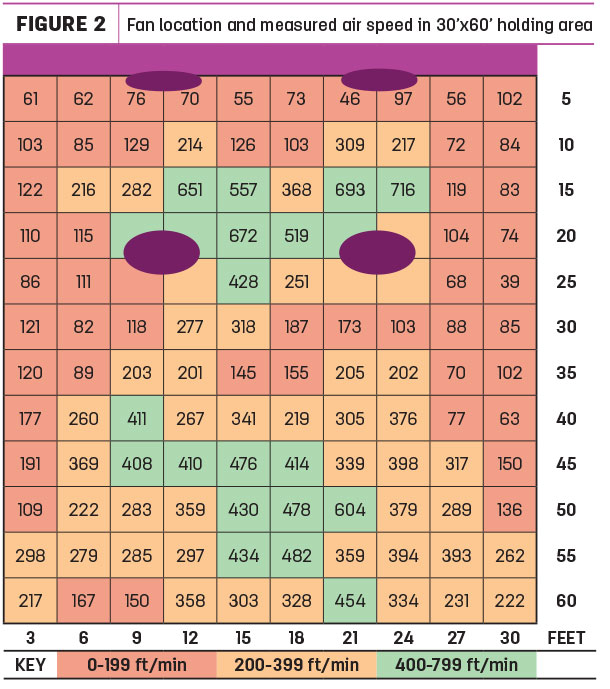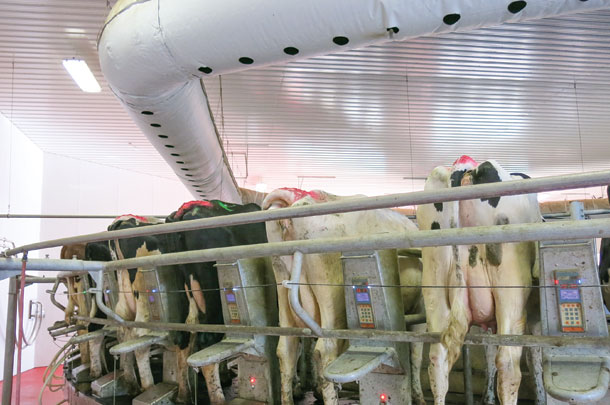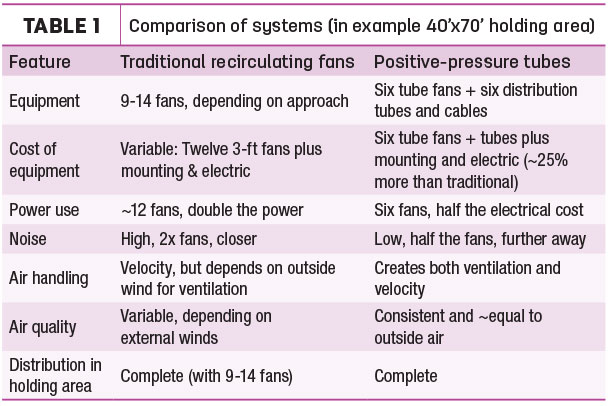The fans and sprinklers in the holding pen may be running, but that does not guarantee cows are effectively cooled in this area, where they may spend several hours each day.
As it turns out, in many holding areas, cows aren’t really cooled at all; their bodies actually gain heat. However, a concept borrowed from the calf barn could bring much- needed relief – and a breath of fresh air – to this part of the dairy operation.
Can’t beat the heat
Dr. Ken Nordlund from the University of Wisconsin’s Dairyland Initiative explains how a cow’s daily routine influences its body temperature and level of heat stress (Figure 1).

When a cow lies down in a stall, its body temperature increases. The cow stands up in an effort to drop it back down. When the cow leaves the barn to be milked and stands in a poorly ventilated, hot, crowded holding area, however, its body temperature sometimes does not decrease.
In fact, the opposite can happen as each cow in the group generates body heat. On average, one 1,500-pound cow producing 80 pounds of milk a day kicks out an amount of body heat equivalent to a 1,500-watt space heater (5,100 BTU per hour). In this type of environment, the cow is gaining heat, not losing it.
After going through the parlor and returning to the barn, the cow has yet to really cool off, so it continues standing instead of lying down in a stall as a means of letting its body temperature cool down again. What is happening, Nordlund explains, is the heat gained in the holding pen actually increases standing time in pens after milking in an effort to dissipate heat, thus robbing the cows of time that should be spent lying down in stalls.
And when cows don’t spend enough time in this resting mode, they pay for it later with sore feet. Nordlund says cows that spending less than 10 hours per day lying down are at risk for laminitis. Heat stress also contributes to reduced feed intakes, lower milk production and a slump in reproductive performance.
Why fans aren’t enough
Even when holding area fans are running at full speed, cows may not be experiencing the benefits of cool, fresh air. Nordlund often sees situations where air does not actually reach the cows or is unequally distributed. Factors that contribute to this problem are fan location, air speed and fan size relative to the coverage area.
The optimal air speed for cooling cows at any given point in a holding area is 200 to 400 feet per minute. In an example given of a typical 30-by-60-foot holding area on a commercial dairy with four recirculating fans, only half of the pen actually receives the minimum air velocity (Figure 2).

That means 50 percent of cows are not truly being cooled during the time they wait to go in to the milking parlor. More dominant cows tend to seek out the prime pockets of cool air, leaving timid cows to retreat to less cooled locations.
Inadequate air speed is one part of the problem in holding pens, while the other is poor air quality due to an insufficient air exchange rate. It’s common for facilities to rely on natural ventilation to bring fresh air into this space, yet wind is neither consistent nor reliable.
Evaluating wind speeds during the month of July in Madison, Wisconsin, revealed 11 days of “still” air, meaning that during potentially the hottest, most humid time of the year, natural ventilation failed to provide much-needed relief. Further, obstructions like adjacent buildings or utility rooms can block the breeze from entering the holding area.
While recirculating fans move air, they fail to introduce fresh air from the outside. The result: hot, humid and dirty air circulates in the given area. Simply increasing the velocity of the fans will do nothing to improve air quality.
A breath of fresh air
As a solution to the challenges of providing effective cooling to relieve heat stress and bring clean, fresh air to holding areas, Nordlund extended a ventilation concept that had proven to be successful in calf barns: positive-pressure tubes.
With a positive-pressure tube system, fans draw in air from outside and distribute it through a plastic tube with a series of precisely spaced holes that direct air flow down onto the cows in a more consistent way. No longer is stuffy air recirculated, nor is there a dependency on the wind to provide moving air.

The system is designed to deliver fresh air vertically, via multiple small air jets, at the desired speed of 400 feet per minute throughout the pen uniformly from one side to the other. By bringing in outside air with lower temperature and humidity, ventilation is achieved, as opposed to just recirculation.
Nordlund’s design is gaining ground and has been implemented on several dairies, including Mystic Valley Dairy. Another dairy extended the positive-pressure tube system beyond the holding pen to improve ventilation and air quality in their rotary milking parlor and above the palpation rail and treatment chutes.
Are positive-pressure tubes the right solution for you?
Dairy producers considering a positive-pressure tube system for their holding pen should keep a few things in mind. The tube systems need to be custom fitted to the specific location, as overall size, width and height needed to clear the crowd gate all affect the choice of components.
A listing of consultants who have attended a training session on these systems can be found on the Dairyland Initiative website.
While the estimated installation cost of a tube system is similar to traditional approaches for holding area cooling, the operating power costs and noise level are cut in half (Table 1).

Also, Nordlund says to be aware that crowd gates can be a limiting factor. The height of the gate when raised for movement of cows determines the location of the tube. Support arms for automatic gates may need to be relocated so they do not interfere with the tubes.
For some operations, positive-pressure tube systems in the holding pen may be the answer to the woes of heat stress that compound in this critical area of the dairy. ![]()
PHOTO 1: Positive-pressure tubes above the palpation rail and treatment chute deliver fresh air to what otherwise might be a congested area.
PHOTO 2: Cows can experience the benefits of positive-pressure tubes in a rotary parlor. Photos courtesy of The Dairyland Initiative.

-
Peggy Coffeen
- Editor
- Progressive Dairyman
- Email Peggy Coffeen





